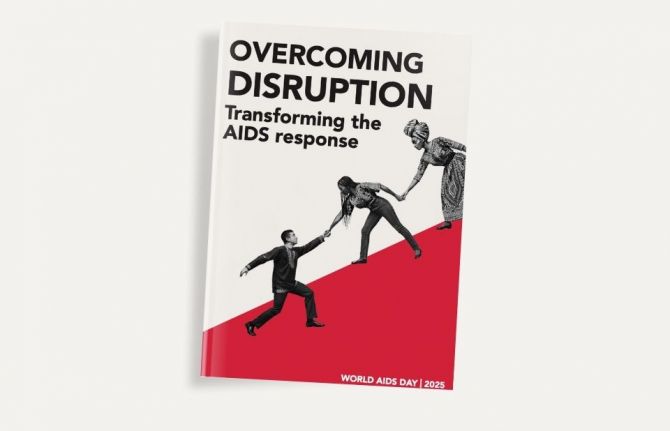
Launch of UNAIDS World AIDS Day Report 2025
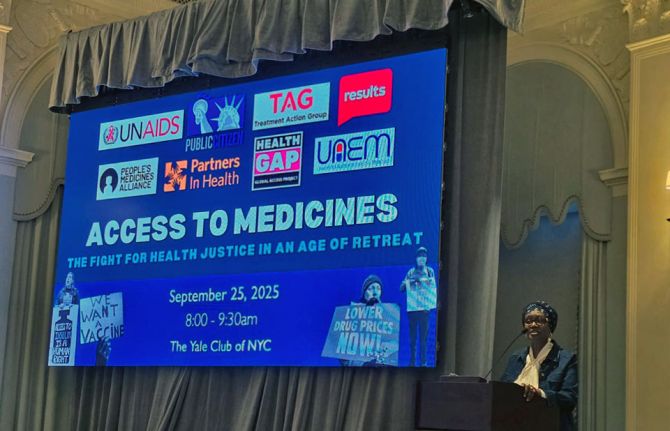

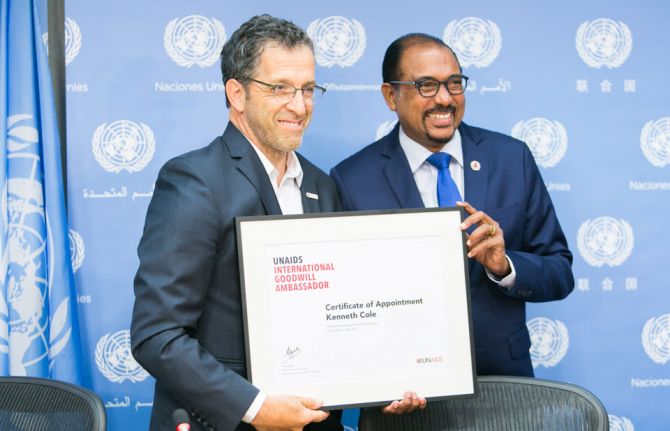
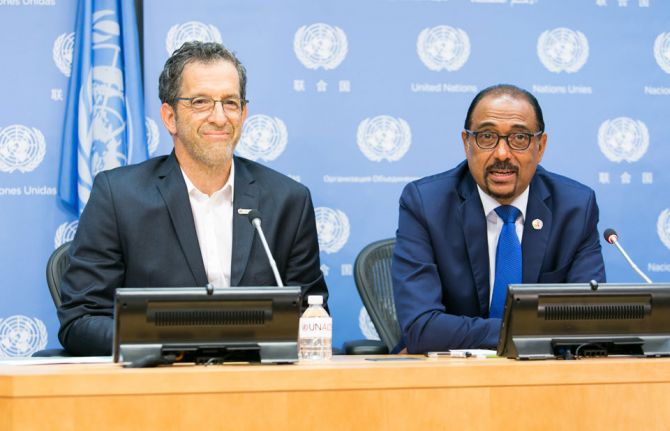
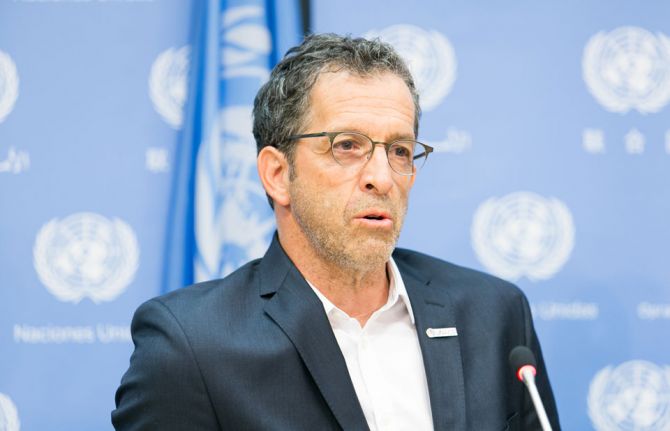

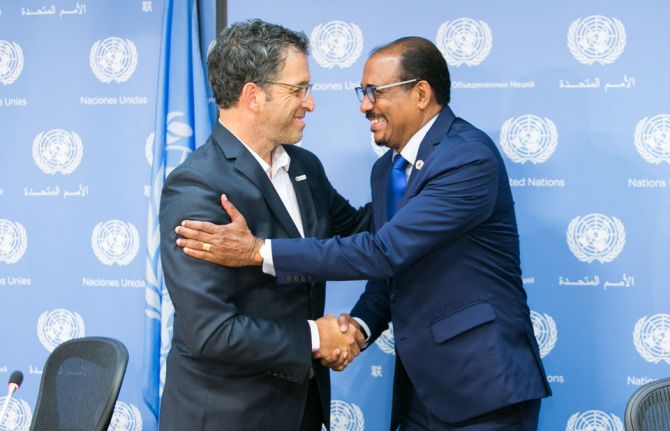
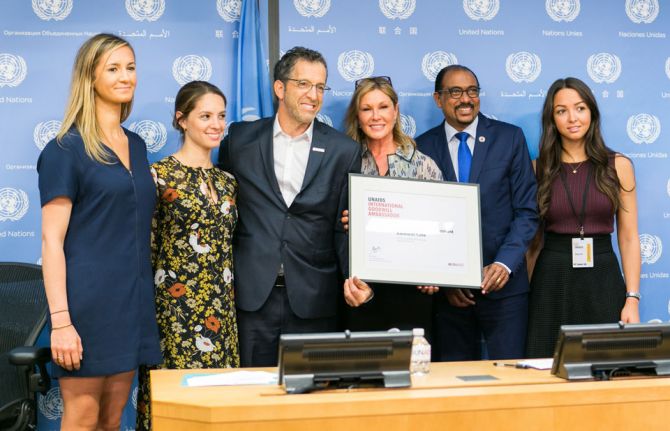
NEW YORK/GENEVA, 7 June 2016—UNAIDS has appointed amfAR Chair and leading fashion designer Kenneth Cole as a UNAIDS International Goodwill Ambassador. The announcement was made at a special event held on the eve of the United Nations General Assembly High-Level Meeting on Ending AIDS, taking place in New York, United States of America, from 8 to 10 June.
“We are entering a crucial phase of the response to HIV and I know that Kenneth can make a significant and powerful contribution towards our shared vision of ending the AIDS epidemic by 2030,” said Michel Sidibé, the Executive Director of UNAIDS. “His commitment, compassion and resolve will magnify our efforts to include everyone and to ensure that no one is left behind.”
In his new role as an International Goodwill Ambassador for UNAIDS, Mr Cole will work to rally the global community by continuing his longstanding role as an advocate for an inclusive response to the AIDS epidemic. He will help with the communication of clear benchmarks and goals in the AIDS response, including amfAR’s mission of finding a cure for HIV by 2020, in order to realize UNAIDS’ vision of ending AIDS as a public health threat by 2030.
“I am confident that if people are put at the centre of the AIDS response we can realize one of this century’s greatest humanitarian achievements—the end of the AIDS epidemic,” said Mr Cole, “I am honoured by this appointment as a UNAIDS International Goodwill Ambassador. It is my hope to help intensify efforts to end the epidemic for everyone, everywhere.”
Mr Cole has been a leading voice in the global response to AIDS for more than 30 years and continues to be a passionate champion for people living with HIV. As well as managing his business interests, Mr Cole has been chairman of amfAR, the Foundation for AIDS Research, since 2005. He was instrumental in the launch of amfAR’s Countdown to a Cure campaign, which supports amfAR’s recently opened Institute for HIV Research, based at the University of California, San Francisco. The mission of the institute is to accelerate progress towards developing a cure for HIV.
UNAIDS
The Joint United Nations Programme on HIV/AIDS (UNAIDS) leads and inspires the world to achieve its shared vision of zero new HIV infections, zero discrimination and zero AIDS-related deaths. UNAIDS unites the efforts of 11 UN organizations—UNHCR, UNICEF, WFP, UNDP, UNFPA, UNODC, UN Women, ILO, UNESCO, WHO and the World Bank—and works closely with global and national partners towards ending the AIDS epidemic by 2030 as part of the Sustainable Development Goals. Learn more at unaids.org and connect with us on Facebook, Twitter, Instagram and YouTube.
Download the printable version (PDF)



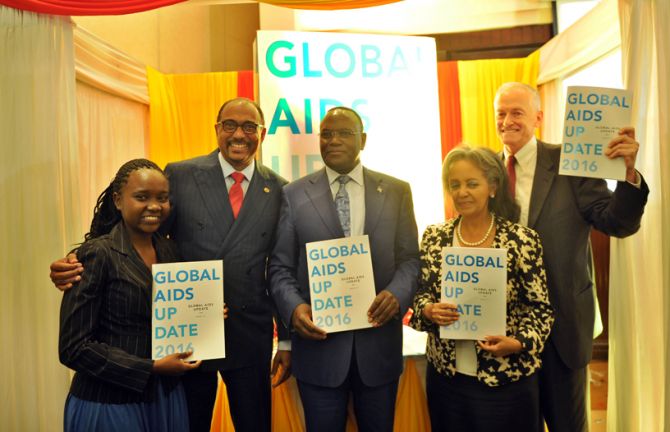

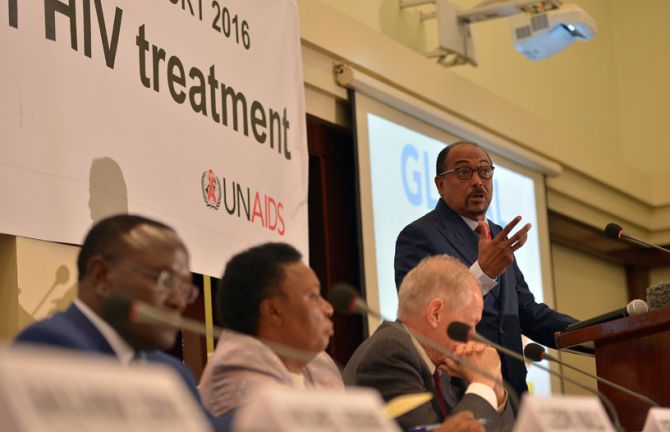
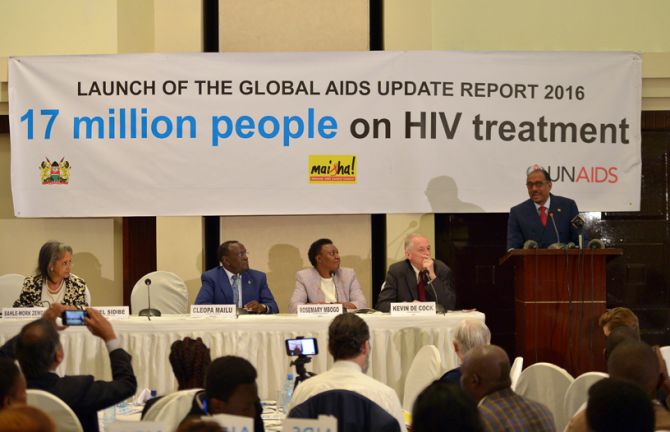
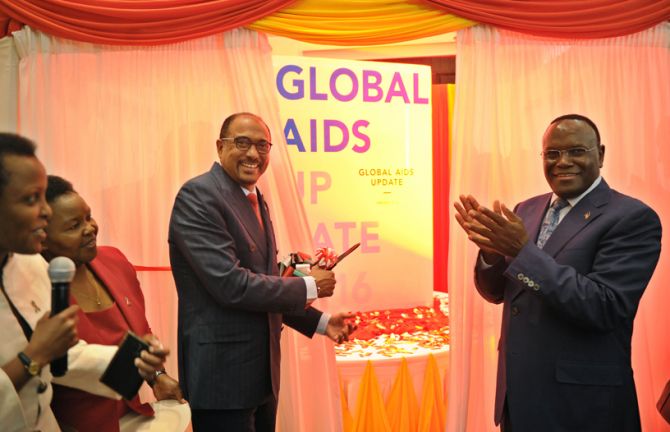
New report from UNAIDS shows that the number of people accessing antiretroviral medicines has more than doubled since 2010
GENEVA/NAIROBI, 31 May 2016—An estimated 17 million people were accessing life-saving antiretroviral medicines at the end of 2015, with an additional 2 million people gaining access over a 12-month period. The announcement, made in a new UNAIDS report entitled Global AIDS update 2016, comes as world leaders prepare to gather for the United Nations General Assembly High-Level Meeting on Ending AIDS, to take place in New York, United States of America, from 8 to 10 June 2016.
The extraordinary scale-up of antiretroviral treatment since 2010 by many of the world’s most affected countries has reduced AIDS-related deaths from 1.5 million in 2010 [1.3 million–1.7 million] to 1.1 million [940 000–1.3 million] in 2015. As more countries adopt new guidelines from the World Health Organization to treat everyone diagnosed with HIV immediately, public health benefits are being realized for individuals and for wider society.
“The full potential of antiretroviral therapy is being realized,” said Michel Sidibé, Executive Director of UNAIDS. “I urge all countries to seize this unprecedented opportunity to put HIV prevention and treatment programmes on the Fast-Track and end the AIDS epidemic by 2030.”
Global coverage of antiretroviral therapy reached 46% [43–50%] at the end of 2015. Gains were greatest in the world’s most affected region, eastern and southern Africa, where coverage increased from 24% [22–25%] in 2010 to 54% [50–58%] in 2015, reaching a total of 10.3 million people. In South Africa, 3.4 million people had access to treatment, followed by Kenya with nearly 900 000. Botswana, Eritrea, Kenya, Malawi, Mozambique, Rwanda, South Africa, Swaziland, Uganda, the United Republic of Tanzania, Zambia and Zimbabwe all increased treatment coverage by more than 25 percentage points between 2010 and 2015.
The report was launched in Nairobi, Kenya, one of the countries showing the most remarkable progress in expanding access to antiretroviral medicines and reducing the number of new HIV infections.
“The Kenyan government, in partnership with UNAIDS and other development partners, is committed to the Fast-Track approach to ending AIDS as a public health threat by 2030,” said Cleopa Mailu, Kenya’s Cabinet Secretary for Health. “We must catalyse investments across different sectors, with a focus on cost-effective and socially inclusive programmes, if we are to succeed.”
The UNAIDS Fast-Track approach to treatment is proven to work in countries adopting it. The momentum must continue to achieve the UNAIDS 90–90–90 treatment target by 2020, whereby 90% of people living with HIV know their status, 90% of people who know their HIV-positive status are accessing treatment and 90% of people on treatment have suppressed viral loads. Reaching the 2020 treatment target will set the world on course to end the AIDS epidemic by 2030 as part of the Sustainable Development Goals.
Reinvigorating HIV prevention
Preventing new HIV infections by countering stigma and discrimination and ensuring that 90% of people have access to HIV combination prevention services will also be crucial to ending the AIDS epidemic.
The UNAIDS report shows that declines in new HIV infections among adults have slowed alarmingly in recent years, with the estimated annual number of new infections among adults remaining nearly static at about 1.9 million [1.7 million–2.2 million]. The global figure masks striking regional disparities that must be addressed to achieve the reductions required to end the AIDS epidemic by 2030.
The largest reduction in new adult infections occurred in eastern and southern Africa. There were about 40 000 fewer adult HIV infections in the region in 2015 than in 2010, a 4% decline. More gradual declines were achieved in the Asia and Pacific region and western and central Africa. Rates of new adult HIV infections were relatively stable in Latin America and the Caribbean, western and central Europe, North America, the Middle East and North Africa. However, the annual number of new HIV infections in eastern Europe and central Asia increased by 57%.
People being left behind
In the report, UNAIDS urges countries to continue to scale up HIV prevention efforts while continuing to roll out treatment, since many people are still not being reached. Young people and adolescents, especially young women and girls, are still being left behind in the AIDS response. Adolescent girls and young women 15–24 years old are at higher risk of HIV infection globally, accounting for 20% of new HIV infections among adults globally in 2015, despite accounting for just 11% of the adult population. In sub-Saharan Africa, adolescent girls and young women account for 25% new HIV infections among adults. Harmful gender norms and inequalities, obstacles to education and sexual and reproductive health services, poverty, food insecurity and violence are the key drivers of this increased vulnerability.
The report also shows that more than 90% of new HIV infections in central Asia, Europe, North America, the Middle East and North Africa in 2014 were among people from key populations and their sexual partners, including gay men and other men who have sex with men, sex workers and people who inject drugs. In sub-Saharan Africa, key populations accounted for more than 20% of new HIV infections. These groups of people are still not being reached with HIV prevention and treatment services despite having the highest rates of HIV prevalence.
The report urges countries to work closely with partners, particularly civil society, communities and people living with HIV, to ensure that they know where their epidemics are concentrated and that they have the right services in the right places.
“We need a people-centred response to the AIDS epidemic that removes all obstacles in the path of people’s access to HIV prevention and treatment services,” said Mr Sidibé. “These services must be fully funded and appropriate to people’s needs so that we can end the AIDS epidemic for everybody.”
The report outlines that science, evidence and policy have opened up a unique opportunity to end the AIDS epidemic by 2030 as part of the Sustainable Development Goals. The global community has to unite around this common goal to realize the full potential of the opportunities or risk the epidemic being prolonged indefinitely.
UNAIDS
The Joint United Nations Programme on HIV/AIDS (UNAIDS) leads and inspires the world to achieve its shared vision of zero new HIV infections, zero discrimination and zero AIDS-related deaths. UNAIDS unites the efforts of 11 UN organizations—UNHCR, UNICEF, WFP, UNDP, UNFPA, UNODC, UN Women, ILO, UNESCO, WHO and the World Bank—and works closely with global and national partners towards ending the AIDS epidemic by 2030 as part of the Sustainable Development Goals. Learn more at unaids.org and connect with us on Facebook, Twitter, Instagram and YouTube.

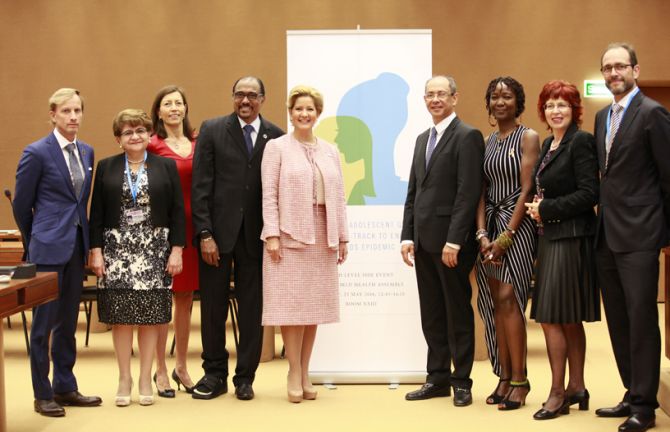


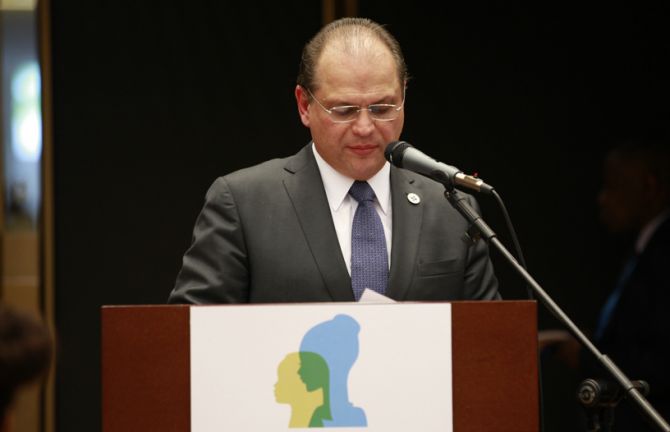
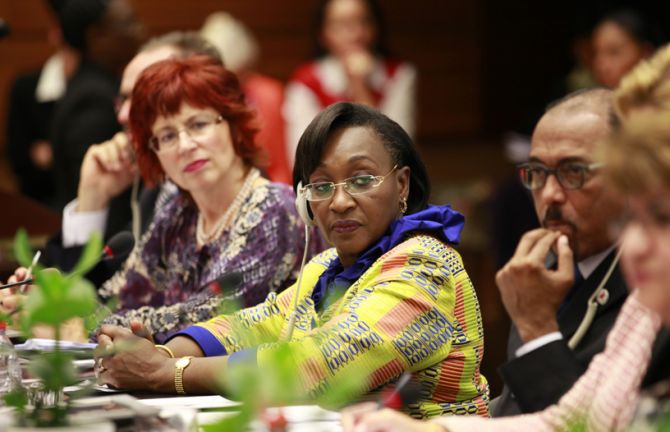
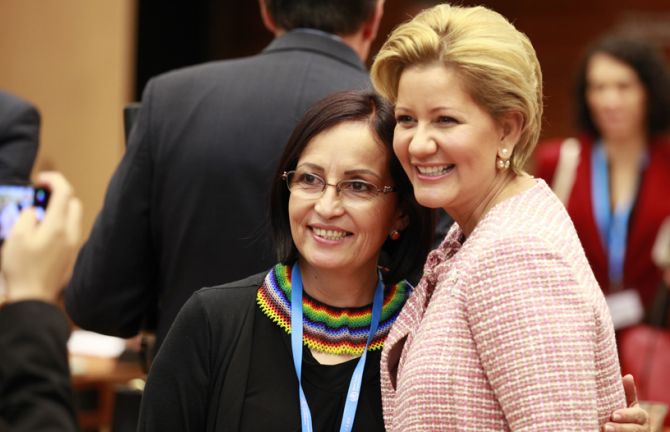
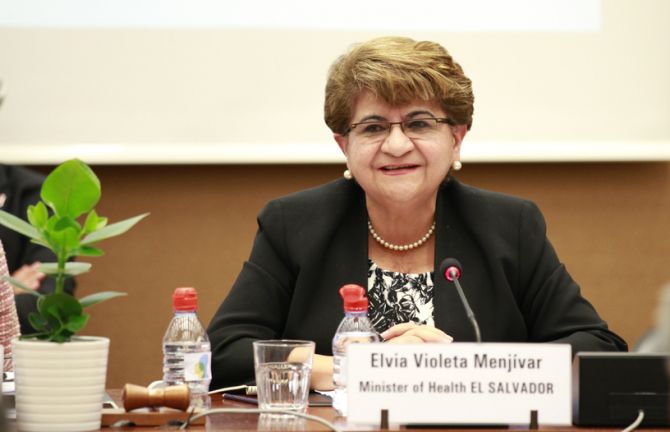
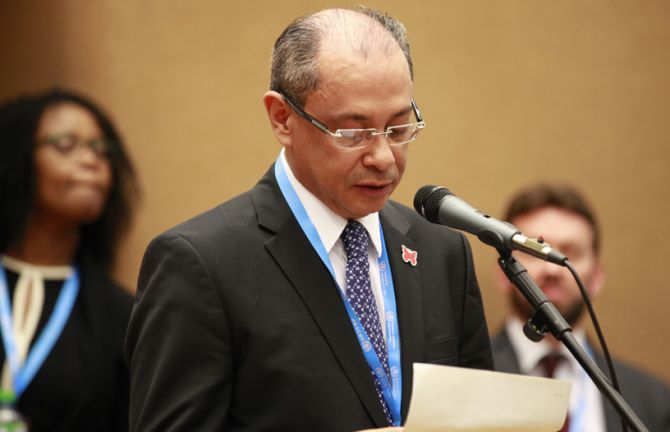
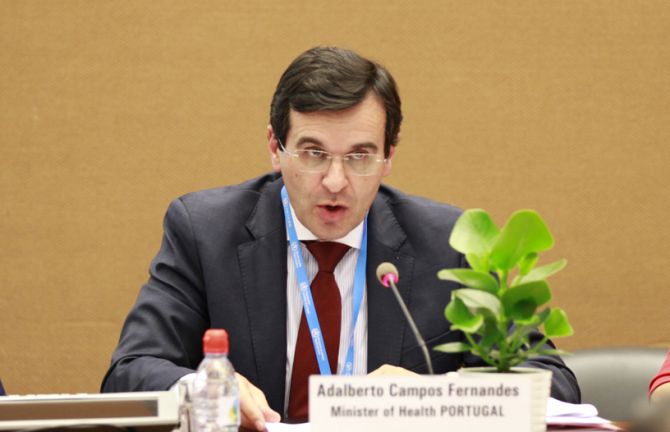
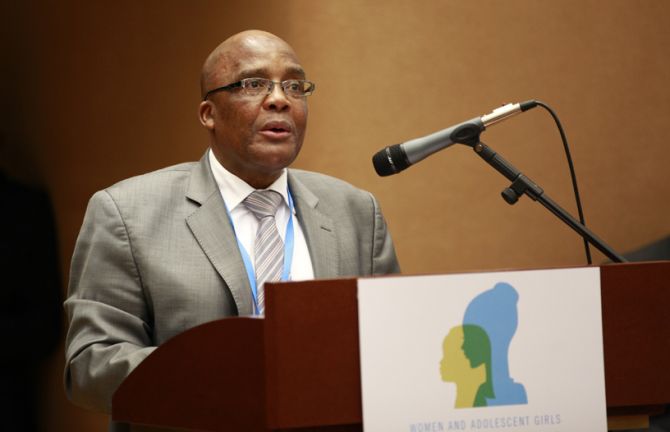
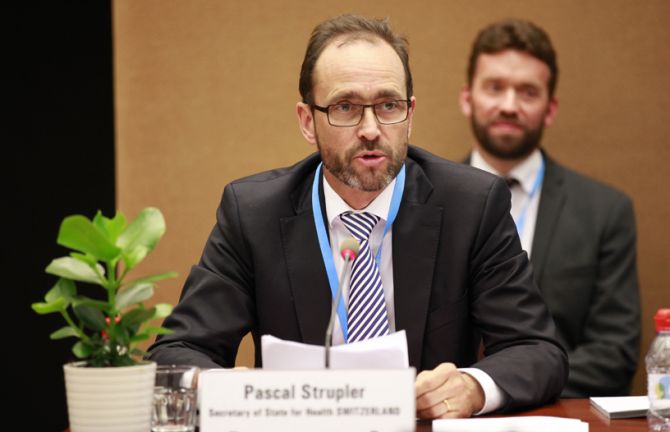
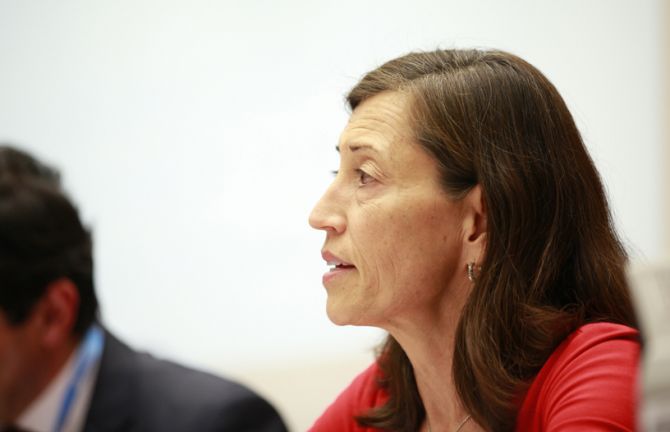
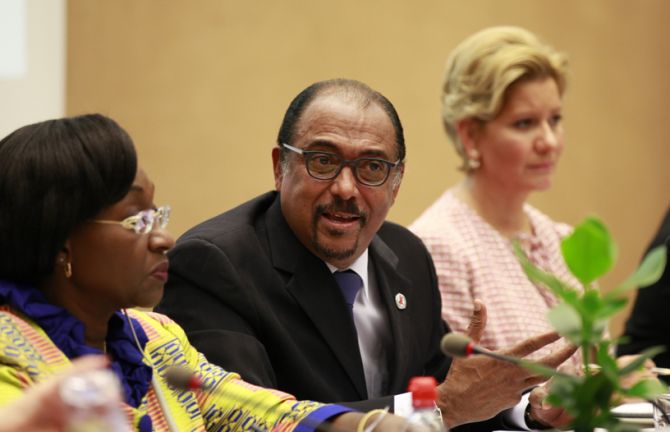
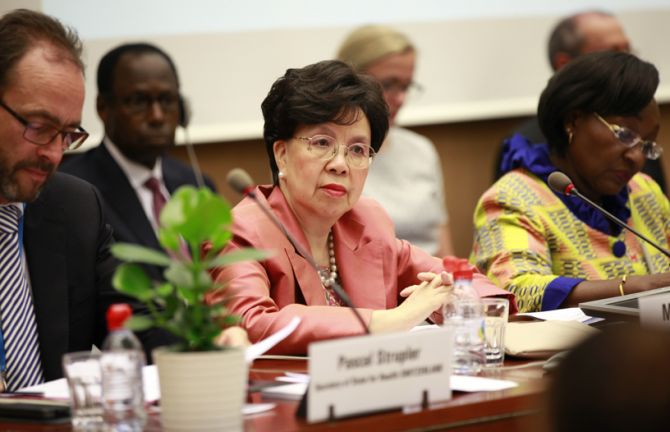
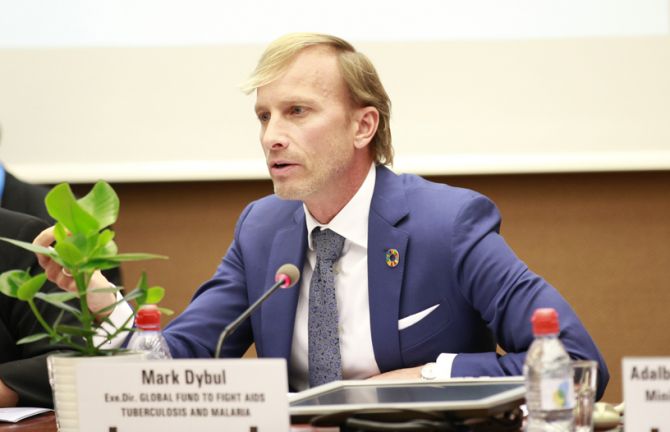

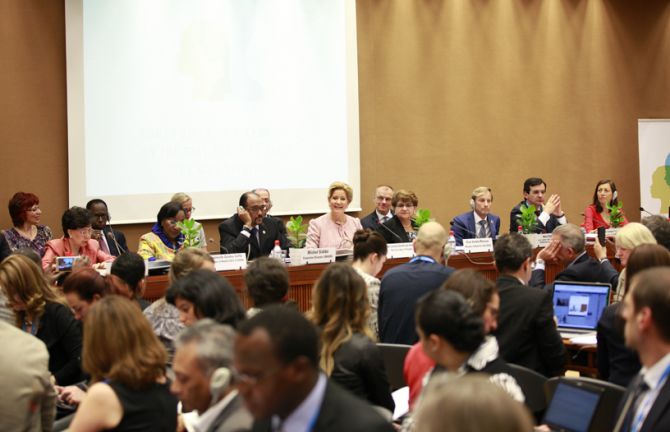
The First Lady of Panama, Lorena Castillo de Varela, said that accelerating the AIDS response and empowering women and girls is key to ending the AIDS epidemic
GENEVA, 23 May 2016—At a high-level side event held during the 69th session of the World Health Assembly, taking place in Geneva, Switzerland, delegates have urged countries to end gender inequity in the response to HIV by putting women and adolescent girls on the Fast-Track to ending the AIDS epidemic. Lorena Castillo de Varela, First Lady of Panama and UNAIDS Special Ambassador for AIDS in Latin America, hosted the event. Ms Castillo de Varela stressed the importance of women assuming leadership roles to ensure the development of programmes and policies fitting to their needs.
“Limited access to health care and education, coupled with systems and policies that do not address the needs of young people, are obstacles that block adolescent girls and young women from being able to protect themselves against HIV, particularly as they transition into adulthood,” said Ms Castillo de Varela. “To reduce HIV infections and AIDS-related deaths, we must advance gender equality, women’s empowerment and autonomy to ensure that girls and young women make independent decisions about their own health and are able to live free from all forms of violence.”
The high-level side event focused on three topics, the elimination of new HIV infections among children, HIV prevention in adolescent girls and young women and access to HIV treatment for all.
The engagement and empowerment of women as leaders, policy makers, implementers and peer supporters combined with increased access to effective HIV treatment and prevention has proved essential in the success of global efforts to eliminate new HIV infections among children, which have decreased by more than half, from 520 000 a year in 2000 to 220 000 in 2014. This comprehensive and inclusive approach now has to be widened to include all people living with HIV, including young women and girls.
“We need a combined, holistic approach and interventions that support adolescent girls and women,” said HIV activist of the Salamander Trust, Angelina Namiba. “It is crucial that women living with HIV are meaningfully involved at all stages of these interventions right from design to delivery.”
Globally, AIDS remains the leading cause of death among women of reproductive age. In 2014, there were around 220 000 new HIV infections worldwide among adolescents (aged 15 to 19 years), with adolescent girls accounting for 62% of new HIV infections among this age group. In 2014, AIDS was the leading cause of death in adolescents in sub-Saharan Africa.
Gender-based violence, gender inequity, harmful gender norms, stigma and discrimination often prevent women and girls from knowing their HIV status and accessing appropriate HIV prevention and treatment services. It is estimated that of 670 000 adolescent girls aged 15 to 19 living with HIV, only one in five knows she is HIV-positive.
The UNAIDS Fast-Track approach focuses on ensuring that at least 90% of adolescents and young women and men (as well as other groups at higher risk of HIV infection) have access to combination HIV prevention and sexual and reproductive health and rights services and that they are empowered with the skills, knowledge and capability to protect themselves from HIV by 2020.
In addition to scaling up HIV prevention, the roll-out of access to HIV treatment is critical. The World Health Organization’s global health sector strategy on HIV, 2016–2021, being discussed at this week’s World Health Assembly reiterates UNAIDS’ 90–90–90 treatment target. This will require that 90% of people living with HIV know their HIV status, 90% of people who know their HIV-positive status are accessing antiretroviral treatment and 90% of people on treatment have suppressed viral loads. To achieve this, innovative models of service delivery will be critical to ensuring that adolescents and young people are diagnosed early, rapidly linked to treatment services, helped to adhere to treatment and retained in care to make sure they stay healthy. These services must be accessible, affordable and sensitive to the needs of women and girls. Other Fast-Track targets include achieving fewer than 500 000 new HIV infections a year by 2020 and reaching zero discrimination.
Switzerland and Zambia, who were among the sponsors of the event in Geneva, are co-facilitators of the United Nations General Assembly High-Level Meeting on Ending AIDS. As co-facilitators they will take forward the summary outcomes of this World Health Assembly side event to help inform discussions at the High-Level Meeting, which will take place in New York, United States of America, from 8 to 10 June 2016.
“Limited access to health care and education, coupled with systems and policies that do not address the needs of young people, are obstacles that block adolescent girls and young women from being able to protect themselves against HIV, particularly as they transition into adulthood. To reduce HIV infections and AIDS-related deaths, we must advance gender equality, women’s empowerment and autonomy to ensure that girls and young women make independent decisions about their own health and are able to live free from all forms of violence.”
“We need a combined, holistic approach and interventions that support women beyond pregnancy. It is crucial that women living with HIV are meaningfully involved at all stages of these interventions right from design to delivery.”
“Besides attending health services to seek care for themselves, many Brazilian women also seek care for their children or other family members. There is in this regard an interconnection between taking care of oneself and caring for others, with women playing a role of caregivers to their family and community.”
“As long as men are not involved, as long as men refuse to not join women in the process, we will not reach our goals of zero new HIV infections. We are determined to end HIV/AIDS and this is why in our last annual meeting on AIDS, the President himself decided to increase funding for the HIV response in a very substantial way.”
“This is a future that we must create, not a reality that we must await.”
“We have reduced the number of HIV cases, we have reduced mortality, we have increased free coverage of antiretroviral therapy, and we have reduced mother-to-child transmission of HIV. All of this we have done in a strategy to combine public resources with community responses.”
“From the outset Panama has conducted epidemiological supervision of HIV. With the leadership of the First Lady we have revitalized our fight against HIV.”
“What must change is guaranteeing access to all forms of prevention, diagnosis, care and treatment for all, especially regarding young women and the most vulnerable populations.”
“Before we implemented the prevention of mother-to-child transmission programme we had 70 000 infections in infants – this has reduced to less than 7 000. Despite this decrease the work is still incomplete – we must get as close to zero infections as possible and we are working hard to achieve this.”
“We express our hope that 2016 will mark an historic change in the response to AIDS: this year must reflect a major turning point in the response towards the end of the epidemic.”
“I’m sure you all agree that adolescence is a precarious period in a girl’s life, when significant physical, emotional and social changes shape her future. But adolescence is also an ideal point to leverage development and diplomacy efforts, to break the cycles of poverty and violence, to keep girls in school, to invest in their future. I am confident we can put women and girls on the Fast Track to ending the AIDS epidemic in the very near future.”
“It is an injustice that women and girls are prevented from reaching information and services that could keep them free from HIV and give them access to treatment. If we are to end the AIDS epidemic by 2030 as part of the Sustainable Development Goals, the world must adopt a people-centred approach that enshrines the right of women and girls to make informed decisions about their health and well-being, including their sexual health and rights.”
"This is an extremely important side event. It’s all about ending the AIDS epidemic and working on a very important group – adolescents. If we neglect this age group, we will not be able to achieve our objective of ending the AIDS epidemic by 2030. I congratulate you for working not only on this issue, but also on the elimination of mother to child transmission of HIV. This will be decisive to ending AIDS."
“HIV and TB are somewhat unique diseases. Not just infectious diseases but diseases of society. And we need to understand that. We have to use not only data but also some good common sense. Medical interventions are not enough. They will not address the fundamental aspects of inequality. Data tell us that both health and education together are key. Keeping girls in school is vital. Adolescent girls and young women are not just an issue we need to address but an investment that we absolutely must make."
UNAIDS
The Joint United Nations Programme on HIV/AIDS (UNAIDS) leads and inspires the world to achieve its shared vision of zero new HIV infections, zero discrimination and zero AIDS-related deaths. UNAIDS unites the efforts of 11 UN organizations—UNHCR, UNICEF, WFP, UNDP, UNFPA, UNODC, UN Women, ILO, UNESCO, WHO and the World Bank—and works closely with global and national partners towards ending the AIDS epidemic by 2030 as part of the Sustainable Development Goals. Learn more at unaids.org and connect with us on Facebook, Twitter, Instagram and YouTube.
Download the printable version (PDF)

Antiretroviral therapy to be offered to all people living with HIV as soon as possible after HIV-positive diagnosis
GENEVA, 13 May 2016—The Government of South Africa has announced a major policy shift that will move the world faster towards the global 90–90–90 treatment target. On 10 May 2016, the South African Minister of Health, Aaron Motsoaledi, announced in his Health Budget Vote Speech to the Parliament of South Africa that the country will implement a new evidence-based policy of offering HIV treatment to all people living with HIV by September 2016. This ground-breaking announcement brings South Africa, which already has the world’s largest HIV treatment programme, in line with the latest World Health Organization guidelines on HIV treatment. South Africa is among the first countries in Africa to formally adopt this policy.
South Africa already encourages everyone who is HIV-negative or who does not know their HIV status to be tested for HIV at least once a year. However, instead of having to undergo an additional test of the immune system (the CD4 cell count) to determine eligibility for treatment, people who are diagnosed HIV-positive will be offered HIV treatment as soon as possible after diagnosis.
“South Africa takes another bold step towards ending its AIDS epidemic by 2030, once again demonstrating that scientific evidence, paired with political will, saves lives,” said UNAIDS Executive Director Michel Sidibé.
This major advance comes only months after the government announced that it will provide pre-exposure prophylaxis (PrEP) to sex workers in 10 sex worker programmes from June this year. South Africa is also considering whether to expand the offer of PrEP to prevent HIV in vulnerable young women, based on the lessons learned from demonstration projects.
These combined efforts demonstrate the South African Government’s commitment to maximizing the benefits of antiretroviral medicines for both the prevention and treatment of HIV. This approach has proved to be highly effective in reducing new HIV infections and AIDS-related deaths in high-prevalence settings, such as South Africa.
Provision of HIV treatment for all is estimated to cost an additional US$ 66 million per year and will be paid for by South Africa from domestic resources in this year’s budget.
While much success has been achieved by the country’s HIV treatment programme, with approximately 3.5 million people on HIV treatment today, the number of new HIV infections is unacceptably high, with an estimated 340 000 new HIV infections in 2014.
“The United Nations has a vision to transform the world through the 2030 Agenda for Sustainable Development,” said Mr Motsoaledi. “Ending the AIDS epidemic as a public health threat by 2030 is among the Sustainable Development Goals. The South African Department of Health is committed to this goal and achieving a long and healthy life for all South Africans.”
UNAIDS
The Joint United Nations Programme on HIV/AIDS (UNAIDS) leads and inspires the world to achieve its shared vision of zero new HIV infections, zero discrimination and zero AIDS-related deaths. UNAIDS unites the efforts of 11 UN organizations—UNHCR, UNICEF, WFP, UNDP, UNFPA, UNODC, UN Women, ILO, UNESCO, WHO and the World Bank—and works closely with global and national partners towards ending the AIDS epidemic by 2030 as part of the Sustainable Development Goals. Learn more at unaids.org and connect with us on Facebook, Twitter, Instagram and YouTube.
Download the printable version (PDF)

New report from the United Nations Secretary-General warns that major gains could be lost if action does not accelerate over the next five years and urges countries to react by front-loading investments and increasing action
NEW YORK, 06 May 2016—A new report released by the United Nations Secretary-General, Ban Ki-moon, warns that the AIDS epidemic could be prolonged indefinitely if urgent action is not implemented within the next five years. The report, On the Fast-Track to end the AIDS epidemic, reveals that the extraordinary acceleration of progress made over the past 15 years could be lost and urges all partners to concentrate their efforts to increase and front-load investments to ensure that the global AIDS epidemic is ended as a public health threat by 2030.
“The AIDS response has delivered more than results. It has delivered the aspiration and the practical foundation to end the epidemic by 2030,” said Mr Ban in the report. “But if we accept the status quo unchanged, the epidemic will rebound in several low- and middle-income countries. Our tremendous investment, and the world’s most inspiring movement for the right to health, will have been in vain.”
The review of progress looks at the gains made, particularly since the 2011 United Nations Political Declaration on HIV and AIDS, which accelerated action by uniting the world around a set of ambitious targets for 2015. “The progress made has been inspiring,” said Mr Ban in the report. “Reaching 15 million people with antiretroviral therapy nine months before the December 2015 deadline is a major global victory.” The report outlines that the rapid treatment scale-up has been a major contributing factor to the 42% decline in AIDS-related deaths since the peak in 2004 and notes that this has caused life expectancy in the countries most affected by HIV to rise sharply in recent years.
The report underlines the critical role civil society has played in securing many of the gains made and the leadership provided by people living with HIV. Community efforts have been key to removing many of the obstacles faced in scaling up the AIDS response, including reaching people at risk of HIV infection with HIV services, helping people to adhere to treatment and reinforcing other essential health services.
A major area of success has been in reducing new HIV infections among children. In 2011 UNAIDS and partners launched the Global Plan towards the elimination of new HIV infections among children by 2015 and keeping their mothers alive at the UN General Assembly High-level meeting on AIDS and in just five years, from 2009 to 2014, new HIV infections have been halved in the countries that account for 90% of all pregnant women living with HIV. Some around 85 countries are now poised to virtually eliminate new HIV infections among children.
In the report, however, Mr Ban also calls the shortfalls in the implementation of the 2011 Political Declaration on HIV and AIDS distressing, revealing that even as new HIV prevention tools and approaches have emerged, HIV prevention programmes have weakened in recent years owing to inadequate leadership, weak accountability and declining funding. He notes that new HIV infections declined by just 8% between 2010 and 2014.
The report draws attention to regions where new HIV infections are continuing to rise—eastern Europe and central Asia, where new HIV infections rose by 30% between 2000 and 2014, mostly among people who inject drugs, the Middle East and North Africa and the Asia–Pacific region.
It notes that gender norms that perpetuate inequality continue to prevail across many societies and that girls and young women remain particularly affected by HIV. Of the 2.8 million young people aged 15–24 years living with HIV in sub-Saharan Africa, 63% were female.
The report highlights that despite the progress made on expanding access to antiretroviral therapy, around 22 million people still do not have access to treatment. The report attributes the most substantial barrier to scaling up HIV treatment as late diagnosis, highlighting that around half of all people living with HIV are unaware of their HIV status—this underscores the urgency of increasing access to HIV testing, particularly for people at higher risk of infection.
Despite the challenges outlined in the report, it does offer substantial hope for the future, stating that if the world can alter the status quo, the AIDS epidemic can be ended as a public health threat by as soon as 2030. To do this, the report outlines that the response needs to be inclusive, accessible and grounded in human rights and that it must focus on scaling up services for the people and places most in need. The report also emphasizes the necessity of repealing punitive laws and repressive policies that criminalize same-sex sexual relations, people who use drugs and sex workers, since they impede access to services.
“We must reinforce rights-based approaches, including those that foster gender equality and empower women,” said Mr Ban in the report. “Access to services must be ensured for the people most affected, marginalized and discriminated against including people living with HIV, young women and their sexual partners in sub-Saharan Africa, children and adolescents everywhere, and gay men and other men who have sex with men, sex workers and their clients, people who inject drugs, transgender people, people in prison, people with disabilities, migrants and refugees.”
The report gives strong emphasis to the links between the response to HIV and the success of the Sustainable Development Goals (SDGs), underlining the strong links to SDG 3 (ensure healthy lives and promote well-being for all), SDG 5 (achieve gender equality and empower women and girls), SDG 10 (reduce inequality in access to services and commodities), SDG 16 (promote just, peaceful and inclusive societies) and SDG 17 (revitalize the partnership for sustainable development).
The report notes that the scale-up of resources in recent years has been a strong driving force behind the progress made in responding to HIV. It estimates that in 2014 US$ 19.2 billion was available in low- and middle-income countries for the response to HIV and that by 2020 resources need to increase to an estimated US$ 26.2 billion to achieve the 2030 target of ending the AIDS epidemic.
The report urges countries to embrace the UNAIDS Fast-Track approach to ending the AIDS epidemic, which will require reaching an ambitious set of goals by 2020, including reducing the numbers of people newly infected with HIV and people dying from AIDS-related causes to fewer than 500 000 per annum and eliminating HIV-related discrimination. Targets to reach these goals include reaching the 90–90–90 treatment target for 2020, which calls for 90% of people living with HIV to know their status, 90% of people who know their HIV-positive status to access treatment and 90% of people on treatment to have suppressed viral loads.
Download the printable version (PDF)

A new UNAIDS report says insufficient coverage of harm reduction programmes and policies that criminalize and marginalize people who inject drugs are failing to reduce new HIV infections
GENEVA, 15 April 2016—Ahead of the United Nations General Assembly Special Session on the World Drug Problem, which will take place from 19 to 21 April in New York, United States of America, UNAIDS has released a new report entitled Do no harm: health, human rights and people who use drugs.
The report shows that the failure of many countries to adopt health- and rights-based approaches resulted in no reduction in the global number of new HIV infections among people who inject drugs between 2010 and 2014. The world has missed the United Nations General Assembly’s target set in 2011 to reduce HIV transmission among people who inject drugs by 50% by 2015.
“Business as usual is clearly getting us nowhere,” said Michel Sidibé, Executive Director of UNAIDS. “The world must learn the lessons of the past 15 years, following the example of countries that have reversed their HIV epidemics among people who inject drugs by adopting harm reduction approaches that prioritize people’s health and human rights.”
The UNAIDS report presents the evidence base for five policy recommendations and 10 operational recommendations that countries should apply to turn around their HIV epidemics among people who inject drugs. These recommendations include the implementation of harm reduction programmes to scale and the decriminalization of the consumption and possession of drugs for personal use.
Data demonstrate that countries implementing health- and rights-based approaches have reduced new HIV infections among people who inject drugs. In other countries, strategies based on criminalization and aggressive law enforcement have created barriers to harm reduction while having little or no impact on the number of people who use drugs. Imprisoning people for the consumption and possession of drugs for personal use also increases their vulnerability to HIV and other infectious diseases, such as hepatitis B, hepatitis C and tuberculosis, while incarcerated.
UNAIDS has developed the UNAIDS 2016–2021 Strategy to put the world on track to ending the AIDS epidemic as a public health threat by 2030—a target within the Sustainable Development Goals. A critical target within this Fast-Track approach is the expansion of a combination of HIV prevention and harm reduction services to reach 90% of people who inject drugs by 2020.
Achieving this target would require annual investment in outreach, needle–syringe distribution and opioid substitution therapy in low- and middle-income countries to increase to US$ 1.5 billion by 2020—a fraction of the estimated US$ 100 billion already spent each year to reduce the supply of and demand for narcotic drugs. In many middle-income countries with large populations of people who inject drugs, harm reduction is funded predominantly by international donors and private foundations.
The UNAIDS report provides many examples of countries that are delivering better outcomes for people who inject drugs by adopting a health-centred approach.
As well as being humane and health-oriented, people-centred programmes are also cost-effective and deliver wider social benefits, such as lower levels of drug-related crime and reduced pressure on health-care systems. For example, each dollar spent on Australia’s needle–syringe programme has an estimated lifetime return on investment of up to US$ 5.50 in averted health-care costs. Opioid substitution therapy has been shown to be cost-effective in its capacity to reduce HIV infections—its cost-effectiveness substantially increases when its wider health, economic, psychological and social benefits are taken into account.
“Health is a human right. Investment in people-centred policies and programmes for people who use drugs is the crucial foundation for a global drugs policy that not only saves lives but is also cost-effective,” said Mr Sidibé.
The UNAIDS Fast-Track approach has a set of targets for 2020 that include reducing new HIV infections to fewer than 500 000. It also calls on countries to ensure that 90% of the more than 12 million people who inject drugs worldwide have access to combination HIV prevention services, including needle–syringe programmes, opioid substitution therapy, condoms and access to counselling, care, testing and treatment services for tuberculosis and bloodborne viruses such as HIV and hepatitis B and C.. Achieving these targets will be a significant step towards ending the AIDS epidemic as a public health threat by 2030.
UNAIDS
The Joint United Nations Programme on HIV/AIDS (UNAIDS) leads and inspires the world to achieve its shared vision of zero new HIV infections, zero discrimination and zero AIDS-related deaths. UNAIDS unites the efforts of 11 UN organizations—UNHCR, UNICEF, WFP, UNDP, UNFPA, UNODC, UN Women, ILO, UNESCO, WHO and the World Bank—and works closely with global and national partners towards ending the AIDS epidemic by 2030 as part of the Sustainable Development Goals. Learn more at unaids.org and connect with us on Facebook, Twitter, Instagram and YouTube.
Download the printable version (PDF)

GENEVA/DAR ES SALAAM, 12 April 2016—UNAIDS International Goodwill Ambassador Her Royal Highness Crown Princess Mette-Marit of Norway has completed a mission to the United Republic of Tanzania to assess progress made in eliminating mother-to-child transmission of HIV and to see how young people are engaging in the country’s AIDS response.
During her visit, Her Royal Highness the Crown Princess visited facilities providing services for women and young people living with HIV and also met with mothers living with HIV whose children have been born free from the virus. She went to one of the 26 PASADA (Pastoral Activities and Services for People with AIDS Dar es Salaam Archdiocese) clinics operating in the Dar es Salaam and Pwani regions that provide HIV prevention, treatment and support services for people and communities most in need. The Crown Princess also engaged with youth activists at the Stepping Stones Community of Practice, which offers life-skills training for adolescents and young people, including comprehensive sexuality education and programmes relating to HIV and gender equality.
“It is moving to meet mothers who are in good health and caring for children born free from HIV thanks to antiretroviral medicines,” said Crown Princess Mette-Marit. “It is also particularly rewarding for me to see young people taking up leadership roles in the AIDS response and being equipped with the skills to guide the United Republic of Tanzania towards an AIDS-free generation.”
At the end of 2014, there were around 1.5 million people living with HIV in the United Republic of Tanzania. The number of new HIV infections declined by more than 50% between 2000 and 2014 and the number of new HIV infections among children dropped by around 70% between 2009 and 2014 as access to HIV services increased.
Crown Princess Mette-Marit has been engaged in the AIDS response since 2003 and advocates for the empowerment of women and young people at events and speaking engagements all over the world.
“The Crown Princess is compassionate and committed to improving the lives of young people living with and affected by HIV around the world,” said UNAIDS Executive Director Michel Sidibé. “Her engagement and sincerity are inspiring and we look forward to continuing to work together to achieve our common goal of ending the AIDS epidemic.”
The Crown Princess was accompanied on the visit by the United Republic of Tanzania’s Minister of Health, Community Development, Gender, Seniors and Children, Ummy Mwalimu. Also on the delegation was the Senior Adviser at the Norwegian Ministry of Foreign Affairs, Section for Global Initiatives, Stein Inge Nesvåg, the Norwegian Ambassador to the United Republic of Tanzania, Hanne-Marie Kaarstad, and the Director General of the Norwegian Agency for Development Cooperation, Jon Lomøy.
Her Royal Highness Crown Princess Mette-Marit of Norway is marking 10 years as an International Goodwill Ambassador for UNAIDS.
UNAIDS
The Joint United Nations Programme on HIV/AIDS (UNAIDS) leads and inspires the world to achieve its shared vision of zero new HIV infections, zero discrimination and zero AIDS-related deaths. UNAIDS unites the efforts of 11 UN organizations—UNHCR, UNICEF, WFP, UNDP, UNFPA, UNODC, UN Women, ILO, UNESCO, WHO and the World Bank—and works closely with global and national partners towards ending the AIDS epidemic by 2030 as part of the Sustainable Development Goals. Learn more at unaids.org and connect with us on Facebook, Twitter, Instagram and YouTube.
Download the printable version (PDF)


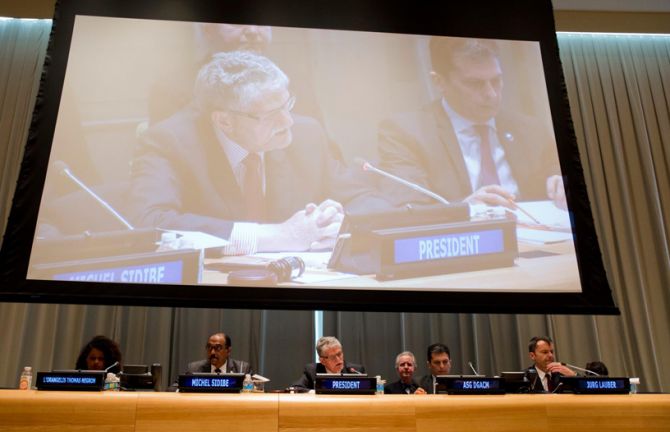
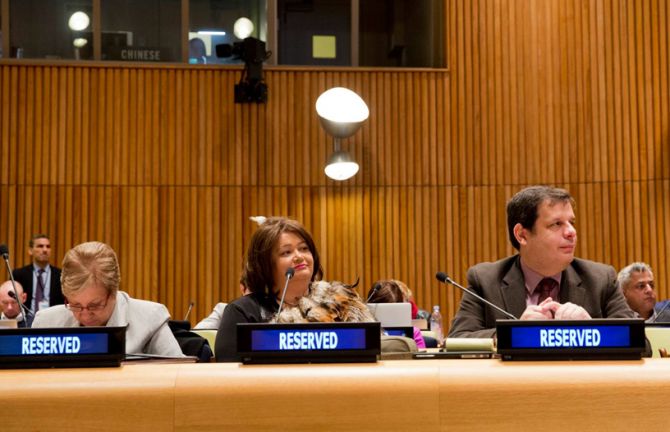

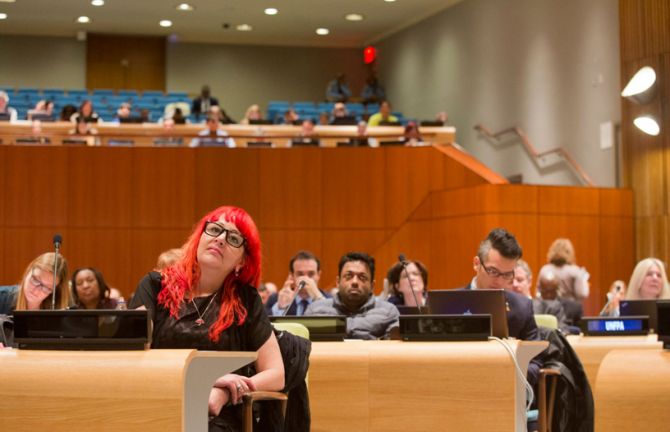
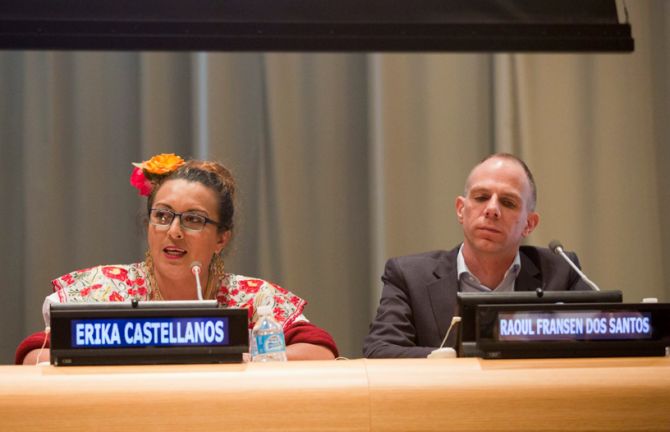
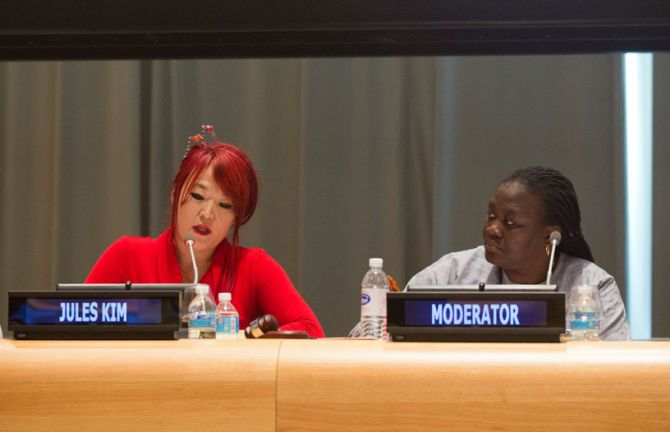
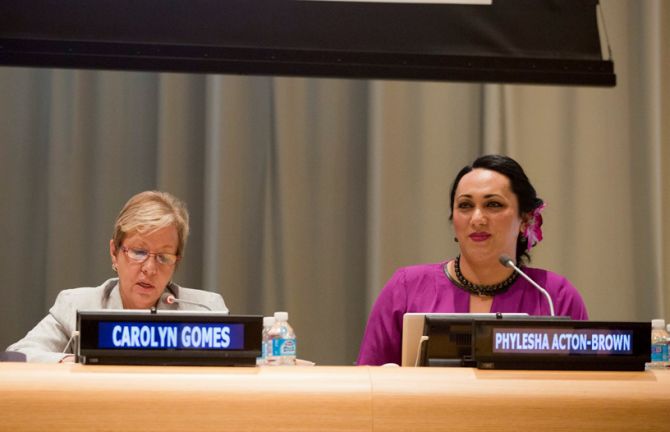



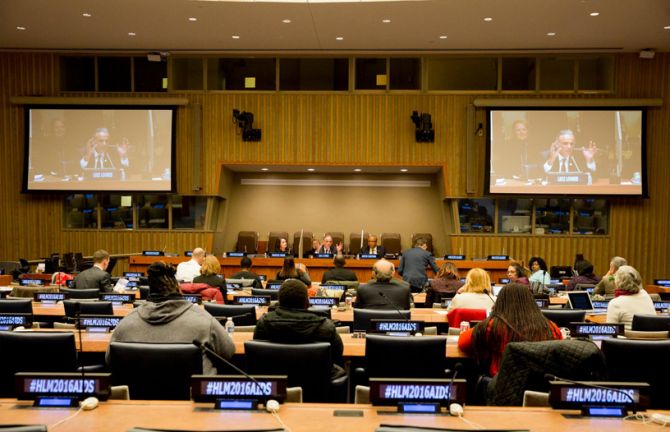
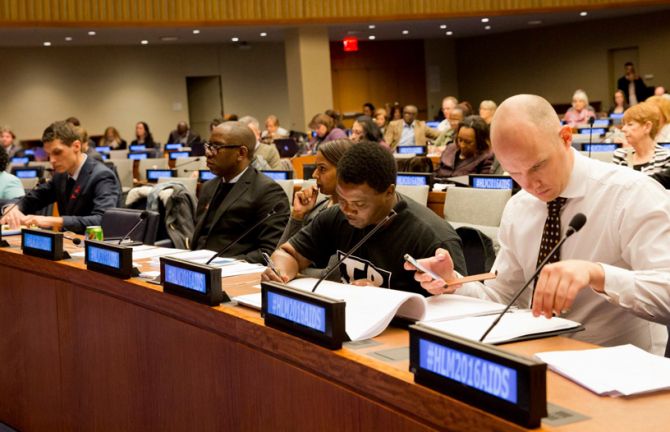
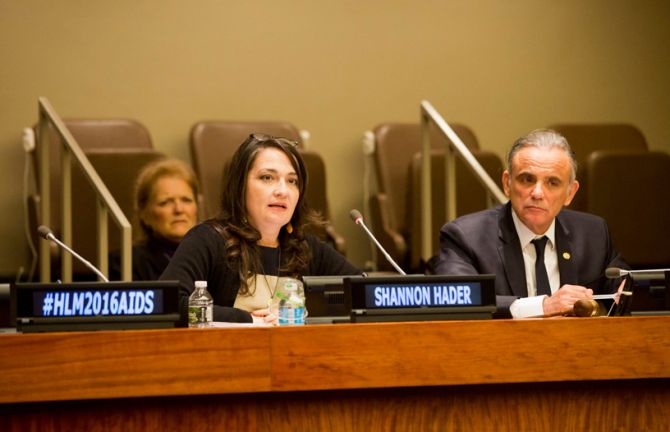

Civil society urges United Nations Member States to include financing, services and rights commitments as priorities in the 2016 Political Declaration on Ending AIDS
NEW YORK, 6 April 2016—At the Informal Interactive Civil Society Hearing on HIV, civil society organizations have called on United Nations Member States and partners to ensure that the response to HIV is fully funded and that financing for community-led action is increased significantly over the next few years. They also called for 30 million people to have access to life-saving HIV treatment by 2020 and for ambitious HIV prevention targets to be met.
The hearing, convened at the United Nations Headquarters in New York, United States of America, by the President of the United Nations General Assembly, is part of the groundwork for the United Nations General Assembly High-Level Meeting on Ending AIDS, which will take place from 8 to 10 June 2016 in New York. The hearing provides an opportunity for civil society organizations to fully contribute to the preparations, to ensure that their voices are heard and that their interests are reflected, and that their recommendations are taken forward in the drafting of the new Political Declaration on Ending AIDS.
“We are aligned in our objectives of ending the AIDS epidemic by 2030,” said Mogens Lykketoft, President of the United Nations General Assembly. “Now we must work together to ensure a strong Political Declaration on Ending AIDS with clear targets that will lead the world to ending the AIDS epidemic as part of the Sustainable Development Goals.”
Representatives of civil society emphasised the need to reach the people most affected by HIV, who continue to be left behind in the AIDS response including sex workers, men who have sex with men, transgender people and people who inject drugs. The representatives also discussed the importance of ensuring a rights-based approach that is inclusive, based on evidence and people-centred during the interactive panel discussions with Member States.
“To end the AIDS epidemic, no one can be left behind,” said Michel Sidibé, Executive Director of UNAIDS. “Civil society advocacy, engagement and service delivery will play a critical role in translating the targets of the Political Declaration on Ending AIDS into real action on the ground to reach even the most marginalized people with life-saving HIV services.”
Community efforts have proven to be essential in overcoming many of the major challenges in the AIDS response, including reaching people most affected by HIV with life-changing HIV services, providing support to help people adhere to their treatment and bolstering other essential health services. Civil society engagement has also been critical in advocating for new resources, improving HIV programming and making progress on human rights issues.
“The cost of inaction is extremely high,” said Marama Pala, of the International Indigenous Working Group on HIV/AIDS and Co-Chair of the Stakeholder Task Force. “Individual communities are where the work gets done. There is no ending AIDS without us.”
UNAIDS estimates that US$ 26.2 billion will be needed for the AIDS response in low- and middle-income countries in 2020—up from the US$ 19.2 billion available in 2014. UNAIDS also underlines that greater investment in civil society advocacy and community-based service delivery will be critical.
By 2020, UNAIDS estimates that investment in community mobilization needs to increase threefold, to 3% of total HIV resources in low- and middle-income countries. Outreach to key populations in low- and middle-income countries is estimated to need to grow to about 7.2% of total HIV investments by 2020, and the estimated resource needs for community-based delivery of antiretroviral therapy need to increase to about 3.8% of total investment for HIV.
The Informal Interactive Civil Society Hearing on HIV included representatives of nongovernmental organizations, the private sector, organizations and networks representing people living with HIV, women, adolescents and young people, and other stakeholders.
UNAIDS
The Joint United Nations Programme on HIV/AIDS (UNAIDS) leads and inspires the world to achieve its shared vision of zero new HIV infections, zero discrimination and zero AIDS-related deaths. UNAIDS unites the efforts of 11 UN organizations—UNHCR, UNICEF, WFP, UNDP, UNFPA, UNODC, UN Women, ILO, UNESCO, WHO and the World Bank—and works closely with global and national partners towards ending the AIDS epidemic by 2030 as part of the Sustainable Development Goals. Learn more at unaids.org and connect with us on Facebook, Twitter, Instagram and YouTube.
Download the printable version (PDF)